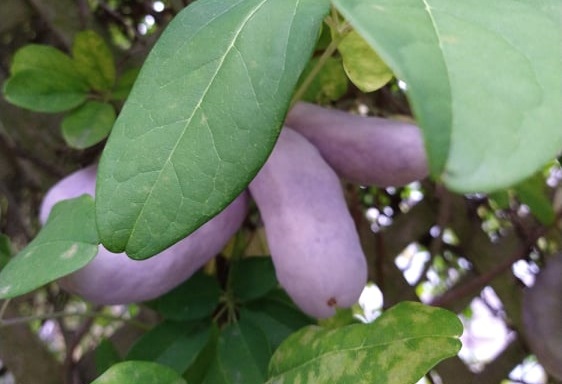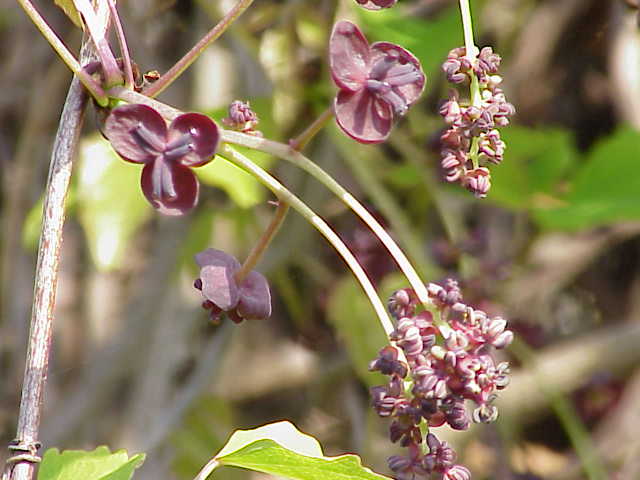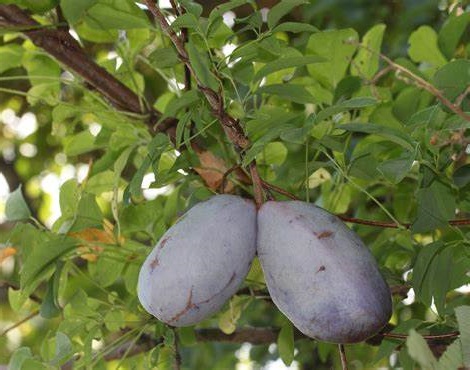|
Akebia
''Akebia'' is a genus of five species of flowering plant, within the family Lardizabalaceae. ''Akebia quinata'' is the most well known species as a minor invader in the majority of the American East Coast and some states in the West Coast. Taxonomy The scientific name, ''akebia'', is a Latinization of , the Japanese name for the species ''A. quinata''. Species There are five species: Hybrids * '' Akebia × pentaphylla '' (Makino) Makino ('' A. quinata'' × '' A. trifoliata'') Fruit ''Akebia quinata'' and '' Akebia trifoliata'' both bear edible fruit, containing a sweet white flesh. Flavor varies greatly in akebias, even within the same species, with some individuals displaying a complex flavor profile resembling a mixture of banana, passionfruit and lychee, with others being mild, or even insipid (flavorless). The "insipid" akebia varieties have the flavor intensity of dragon fruit ''Akebia'' in Japan ''Akebia'' is often mentioned in Japanese literature, where it is ... [...More Info...] [...Related Items...] OR: [Wikipedia] [Google] [Baidu] |
Akebia Quinata
''Akebia quinata'' –commonly known as , chocolate vine, five-leaf chocolate vine, or five-leaf akebia– is a vine that is native to Japan, China and Korea, commonly used as an Ornamental plant, ornamental or edible plant in the United States and Europe. In its native habitat, it is often found on hills, in hedges, on trees, along forest edges and streams, and on mountainous slopes. Etymology ''Akebi'', its Japanese language, Japanese vernacular name, was originally written as け; it derives from and , due to its fruit splitting open when ripe. The epithet ''quinata'' means 'divided into five' and is presumably a reference to its lobed leaves. Description ''Akebia quinata'' is a climbing evergreen vine that grows to or more in height and has palmately compound leaves with five elliptic or obovate leaflets that are notched at the tip. The woody stems are greyish-brown with lenticels. The flowers are clustered in racemes and are chocolate-scented, with three or four sepa ... [...More Info...] [...Related Items...] OR: [Wikipedia] [Google] [Baidu] |
Akebia Trifoliata1
''Akebia'' is a genus of five species of flowering plant, within the family Lardizabalaceae. ''Akebia quinata'' is the most well known species as a minor invader in the majority of the American East Coast and some states in the West Coast. Taxonomy The scientific name, ''akebia'', is a Latinization of , the Japanese name for the species ''A. quinata''. Species There are five species: Hybrids * ''Akebia × pentaphylla '' (Makino) Makino ('' A. quinata'' × '' A. trifoliata'') Fruit ''Akebia quinata'' and ''Akebia trifoliata'' both bear edible fruit, containing a sweet white flesh. Flavor varies greatly in akebias, even within the same species, with some individuals displaying a complex flavor profile resembling a mixture of banana, passionfruit and lychee, with others being mild, or even insipid (flavorless). The "insipid" akebia varieties have the flavor intensity of dragon fruit ''Akebia'' in Japan ''Akebia'' is often mentioned in Japanese literature, where it is evoc ... [...More Info...] [...Related Items...] OR: [Wikipedia] [Google] [Baidu] |
Akebia Quinata 003
''Akebia'' is a genus of five species of flowering plant, within the family Lardizabalaceae. ''Akebia quinata'' is the most well known species as a minor invader in the majority of the American East Coast and some states in the West Coast. Taxonomy The scientific name, ''akebia'', is a Latinization of , the Japanese name for the species ''A. quinata''. Species There are five species: Hybrids * '' Akebia × pentaphylla '' (Makino) Makino ('' A. quinata'' × '' A. trifoliata'') Fruit ''Akebia quinata'' and '' Akebia trifoliata'' both bear edible fruit, containing a sweet white flesh. Flavor varies greatly in akebias, even within the same species, with some individuals displaying a complex flavor profile resembling a mixture of banana, passionfruit and lychee, with others being mild, or even insipid (flavorless). The "insipid" akebia varieties have the flavor intensity of dragon fruit ''Akebia'' in Japan ''Akebia'' is often mentioned in Japanese literature, where it is e ... [...More Info...] [...Related Items...] OR: [Wikipedia] [Google] [Baidu] |
Akebia Apetala
''Akebia'' is a genus of five species of flowering plant, within the family Lardizabalaceae. ''Akebia quinata'' is the most well known species as a minor invasive species, invader in the majority of the East Coast of the United States, American East Coast and some states in the West Coast of the United States, West Coast. Taxonomy The scientific name, ''akebia'', is a Latinization of , the Japanese language, Japanese name for the species ''A. quinata''. Species There are five species: Hybrids * ''Akebia × pentaphylla '' (Makino) Makino (''Akebia quinata, A. quinata'' × ''Akebia trifoliata, A. trifoliata'') Fruit ''Akebia quinata'' and ''Akebia trifoliata'' both bear edible fruit, containing a sweet white flesh. Flavor varies greatly in akebias, even within the same species, with some individuals displaying a complex flavor profile resembling a mixture of banana, passionfruit and lychee, with others being mild, or even insipid (flavorless). The "insipid" akebia varietie ... [...More Info...] [...Related Items...] OR: [Wikipedia] [Google] [Baidu] |
Akebia Trifoliata
''Akebia trifoliata'' also known as chocolate vine, three leaf chocolate vine or three leaf akebia, is a species of flowering plant. It is a close relative of the more commonly known ''Akebia quinata.'' Description ''Akebia trifoliata'' is a vine, climbing vine with leaves composed of three ovate, slightly lobed leaflets, often bronze-tinted when young. It grows up to long. It loses its leaves in cold climates, but the twining woody branches are handsome even when bare. Flowers are deep purple in short racemes and followed by light purple fruits. Like ''Akebia quinata'', it grows in Hardiness zone, USDA hardiness zones from 5a to 9b: from −20 °F (−28.9 °C) to 30 °F (−1.1 °C). Uses Culinary uses The plant is grown for its ornamental appeal but also for the edible oblong purplish fruits. The fruit itself has a mild flavor reminiscent of coconut or tapioca and is considered quite sweet. It has a mild melon flavor when eaten ripe Medicinal ... [...More Info...] [...Related Items...] OR: [Wikipedia] [Google] [Baidu] |
Akebia Longeracemosa (14168601575)
''Akebia longeracemosa'' or long-racemed akebia is a member of the chocolate vine genus, ''Akebia'', and more specifically a relative of the commonly known, ''Akebia quinata ''Akebia quinata'' –commonly known as , chocolate vine, five-leaf chocolate vine, or five-leaf akebia– is a vine that is native to Japan, China and Korea, commonly used as an Ornamental plant, ornamental or edible plant in the United States a ....'' Description It is a twining, semi-evergreen climbing vine which grows up to 8m tall with bright green foliage comprising five, oblong leaflets that may be tinged purple in winter. Fragrant, cup-shaped, purple-red spring flowers borne in pendulous racemes to 15cm long may be followed by purplish, sausage-shaped fruits if cross pollination between two separate species or varieties occurs. Morphological and molecular evidence suggests that ''A. longeracemosa'' is possibly a hybrid between '' A. quinata'' and '' A. trifoliata''. Uses Culinary Like most ... [...More Info...] [...Related Items...] OR: [Wikipedia] [Google] [Baidu] |
Akebia Chingshuiensis
''Akebia chingshuiensis'' is a member of the ''Akebia'' family native to China. It is a rarer species of ''Akebia'' and has a smaller range than ''Akebia trifoliata'' or ''Akebia quinata''. Description ''Akebia chingshuiensis'' is a subspecies of ''Akebia trifoliata'' from China and has been used in traditional Chinese medicine Traditional Chinese medicine (TCM) is an alternative medicine, alternative medical practice drawn from traditional medicine in China. A large share of its claims are pseudoscientific, with the majority of treatments having no robust evidence ... for over 2000 years. References Lardizabalaceae Plants described in 1961 Plants used in traditional Chinese medicine {{Ranunculales-stub ... [...More Info...] [...Related Items...] OR: [Wikipedia] [Google] [Baidu] |
Lardizabalaceae
Lardizabalaceae is a family (biology), family of flowering plants. The family has been universally recognized by taxonomists, including the APG II system (2003; unchanged from the APG system of 1998), which places it in the order Ranunculales, in the clade eudicots. The family consist of 7 genera with about 40 known species of woody plants. All are lianas, save ''Decaisnea'', which are pachycaul shrubs. The leaf, leaves are alternate, and compound (usually palmate), with pulvinate leaflets. The flowers are often in drooping racemes. They are found in eastern Asia, from the Himalayas to Japan, with the exception of the genera ''Lardizabala'' and ''Boquila'', both native to southern South America (Chile, and ''Boquila'' also in adjacent western Argentina). The extinct genus ''Kajanthus'' is known from the Early Cretaceous of Portugal. Genera References External links * Lardizabalaceae in the ''Flora of North America''Lardizabalaceae in the ''Flora of China''links at CSDLChi ... [...More Info...] [...Related Items...] OR: [Wikipedia] [Google] [Baidu] |
Joseph Decaisne
Joseph Decaisne (7 March 1807 – 8 January 1882) was a French botanist and agronomist. He became an ''aide-naturaliste'' to Adrien-Henri de Jussieu (1797–1853), who served as the chair of rural botany. It was during this time that he began to study plants brought back by various travelers like those of Victor Jacquemont (1801–1832) from Asia. Decaisne used applied research, most notably on the agronomy of the madder, the yam and the ramie. He was also interested in algae. Biography Although born in Brussels, Belgium, he exercised his activity exclusively in Paris. He entered in 1824 as a gardener at the ''Muséum national d'histoire naturelle'' (French museum of natural history) and became, in 1832, head of the ''carré des semis'' section. He also worked at the '' Jardin des Plantes'' and collaborated with Asa Gray. In 1847 he chaired Statistical Agriculture department in the College de France. In 1850, Decaisne followed Charles-François Brisseau de Mirbel (1776–185 ... [...More Info...] [...Related Items...] OR: [Wikipedia] [Google] [Baidu] |
Japanese Literature
Japanese literature throughout most of its history has been influenced by cultural contact with neighboring Asian literatures, most notably China and its literature. Early texts were often written in pure Classical Chinese or , a Chinese-Japanese creole language. Indian literature also had an influence through the spread of Buddhism in Japan. During the Heian period, Japan's original culture () developed and literature also established its own style, with the significant usage and development of to write Japanese literature. Following the end of the policy and especially during the increasing westernization of the Meiji era, Western literature has also had an influence on the development of modern Japanese writers, while Japanese literature has in turn become more recognized internationally, leading to two Japanese Nobel laureates in literature, namely Yasunari Kawabata and Kenzaburō Ōe. History Nara-period literature (before 794) Before the introduction of kanji ... [...More Info...] [...Related Items...] OR: [Wikipedia] [Google] [Baidu] |





